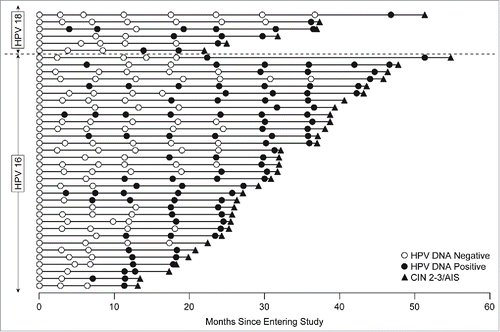Figures & data
Figure 1. Timeline of HPV16/18 positivity in subjects who developed HPV16/18-related CIN2+. Each horizontal line corresponds to one of the 39 cases; the horizontal axis shows time since entering the study. Circles indicate cervical swab sampling visits: open circles are shown when the subject was HPV DNA negative to the type which was later present in the disease; closed circles show DNA positivity to that HPV type. The closed triangle indicates the diagnosis of HPV16/18-related CIN2, CIN3 or AIS. Though the definition of persistent infection allowed for a swab or biopsy sample to be positive for the same HPV type after a pathology panel diagnosis of disease, in all of the cases shown in Figure 1, the persistent infection was detected prior to definitive therapy.

Table 1. HPV 16/18-related CIN2+ by prior 6-month or 12-month HPV16/18 persistent infection. Subjects received placebo and were naïve to the relevant HPV type at day 1.
Table 2. Statistical summary measures of the relationship between HPV16/18-related persistent infection (6-month and 12-month) and HPV16/18-related CIN2+.
